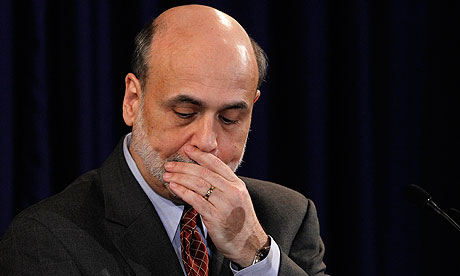Results 1 to 2 of 2
Thread Information
Users Browsing this Thread
There are currently 1 users browsing this thread. (0 members and 1 guests)
Threaded View
-
06-04-2011, 08:06 PM #1Senior Member


- Join Date
- May 2007
- Location
- South West Florida (Behind friendly lines but still in Occupied Territory)
- Posts
- 117,696
Dismal employment figures cap a grim month for US economy
Dismal employment figures cap a grim month for US economy
Some are calling it a 'soft patch' – but the increase in the US jobless rate could be evidence a storm is brewing
Larry Elliott, economics editor
guardian.co.uk, Friday 3 June 2011 16.07 BST
29 Comments

US Federal Reserve chief Ben Bernanke is in no hurry to slash spending while the US economy is still showing so many signs of weakness. Photograph: Jason Reed/Reuters
A bombed-out real estate market. Weak consumer spending. A squeeze on real incomes. Now a dismal report on the labour market. This is turning into a grim month for the US, where there is now a clear danger of what was already a feeble economic recovery running into the sand. Perhaps the most worrying feature of the non-farm payrolls figures was that the weakness of jobs growth came as little surprise.
Earlier this week, Wall Street had pencilled in an increase of around 200,000 in non-farm payrolls last month, but the forecasts had already been revised downwards before it was revealed that the net increase in employment in May was just 54,000. The US needs to boost payrolls by at least 100,000 a month just to prevent unemployment going up, and the jobless rate edged up again to 9.1%.
Some economists describe this as a "soft patch", arguing that the current weakness is a temporary deviation from an upward trend. The Conference Board said the economy was displaying signs of "choppiness". That's one of putting it.
Those who think this is "choppiness", rather than evidence of a storm brewing, say that the key to jobs growth is the private service sector, where demand for labour is currently poor due to the squeeze on consumer incomes caused by rising gasoline prices. The price of oil is now falling, which should give consumers more money to spend on goods and services.
In addition, Wall Street has responded to signs of tepid growth by pushing back the timing of any tightening of monetary policy from the Federal Reserve until deep into next year. That has pushed bond yields lower, making the cost of financing mortgages cheaper.
As a result, so this line of thinking goes, the second half of 2011 will be better. Even the 5,000 drop in manufacturing employment can be explained away by the supply-chain problems caused by the Japanese earthquake and tsunami. The American jobs machine will splutter back into life over the next few months.
The fact is, though, that the "American jobs machine" – a feature of previous economic recoveries - has been noticeable by its absence since growth reached a trough in early 2009. That's despite the Federal Reserve and the US treasury using every conventional weapon at their disposal – and one or two unconventional ones as well – to get unemployment down to the 5%-6% range.
So what conclusions can we draw from today's figures? The first is simple. The US has had very little bang for the buck from an unprecedented package of economic stimulus.
Second, the debate between those in favour of more policy easing versus those supporting policy tightening has tilted in favour of those who say the Fed should be wary of pushing up interest rates and should be mulling the possibility of a third dose of quantitative easing.
A few months ago, the bond market vigilantes fretting about the risk of higher interest rates as a result of the budget deficit were in the ascendancy. But as Paul Krugman noted this week, the yield on the benchmark 10-year treasury bill is below 3% while unemployment is at 9%. The White House is going to be in no hurry to bow to Republican demands to slash spending in those circumstances.
Finally, there's a conclusion for the UK. If the US is doing this badly after all that stimulus, what does it say for Britain's prospects, where fiscal policy is being tightened aggressively? History suggests that what happens in the US happens here with a lag of around six months.
http://www.guardian.co.uk/business/2011 ... grim-monthJoin our efforts to Secure America's Borders and End Illegal Immigration by Joining ALIPAC's E-Mail Alerts network (CLICK HERE)


 LinkBack URL
LinkBack URL About LinkBacks
About LinkBacks






 Reply With Quote
Reply With Quote

PALESTINIANS COMING TO YOUR TOWN!
05-18-2024, 09:11 PM in Videos about Illegal Immigration, refugee programs, globalism, & socialism